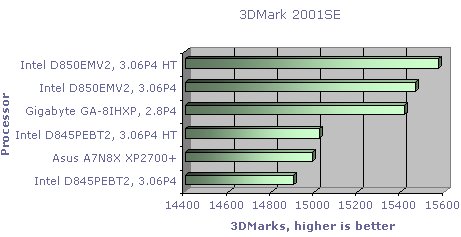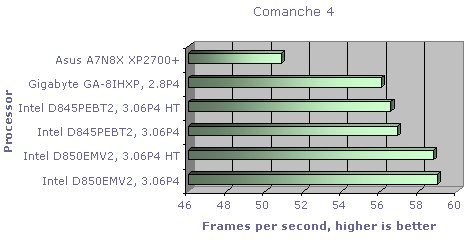|
Let's start off with a look at a few of our favourite 3D based benchmarks, 3DMark 2001SE, Quake3, Serious Sam 2 and Comanche 4.
3DMark 2001SE up first, a full system benchmark that needs good performance in all the areas of your system to crank out the good numbers. How does the BT2 do with its DDR memory up against an RDRAM solution with the same CPU, a powerful RDRAM based 2.8 box and XP2700+ and nForce2?
 3DMark 2001SE performance
3DMark 2001SE performance
Performance is slightly less than I'd expected, I was expecting it to pull ahead of the XP2700+ by virtue of raw CPU performance, but it's slightly slower than that with the HT and non-HT results sitting either side of the AMD system. All the RDRAM based combinations were able to draw ahead of the BT2 due to what looks like superior memory performance.
Will Quake3 show the same types of results and keep the RDRAM boxes at the top of the heap compared to the DDR based BT2?
 Quake3 performance
Quake3 performance
XP2700+ is ommitted here due to my inability to make the setup generate a respectable Q3 result in the ballpark it should have been. So only P4 based solutions in the graph and how does the BT2 do? Raw CPU power takes it above the 2.8 + RDRAM but the mighty D850EMV2 and the 3.06 take the top spots with massive 500fps+ results.
Let's take a look at the Serious Sam 2 graph and see if memory bandwidth makes a difference here, putting the BT2 at a disadvantage against the competition.
 Serious Sam 2 performance
Serious Sam 2 performance
Slotting in above the AMD solution, it fits behind all the RDRAM results giving us another indication of what memory performance gives you in terms of 3D gaming performance.
Lastly before we turn the page, a quick look at Comanche 4, a traditionally CPU based benchmark.
 Comanche 4 performance
Comanche 4 performance
Raw CPU power takes it above the AMD solution and the 2.8 P4 in the Gigabyte showing that the BT2, despite being a DDR based solution, can still push good numbers compared to RDRAM given similar components to work with. On to the UT2003 numbers before a look at some non 3D based benchmarks.
|